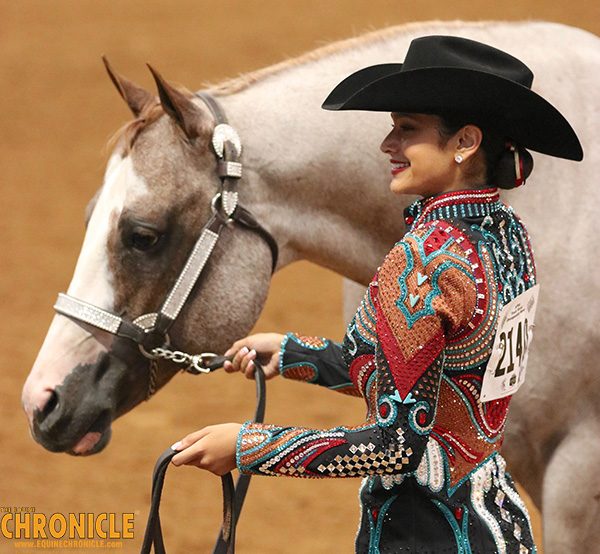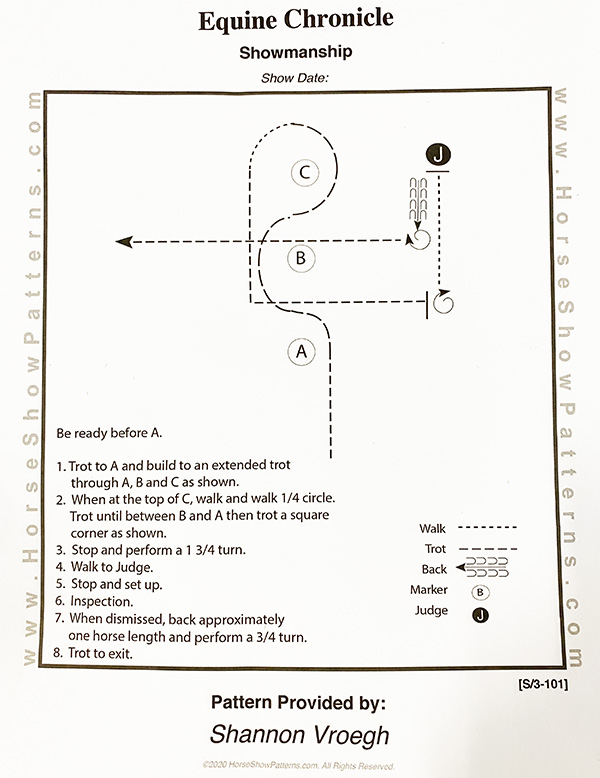COVID-19 Schooling Survival Guide- Showmanship

By: Brittany Bevis
In continuation of our highly popular COVID-19 Schooling Survival Guide, we have a special Showmanship pattern, just for Equine Chronicle readers, courtesy of Shannon Vroegh. But before you tackle the pattern itself, Shannon explains what she believes are the most important factors in a successful Showmanship performance.
“I feel like Showmanship is the most up close and personal class at the horse show,” she says. “You’re on the ground in front of the judge, and you have to work directly to them or in front of them while they’re sitting in chairs. They’re right there able to scrutinize your every move, or so it feels that way. That’s why I feel the two most important factors in Showmanship are your comfort and confidence in yourself and your horse.”
“Can you walk a straight line to the judge and look him or her in the eye? Can you smile at him or her with the confidence that says, ‘I’m your winner today?’ Have you spent enough time with your horse that you’re confident enough to be thinking about your presence in the arena and not what your partner is doing next to you? The better you get at schooling difficult patterns at home is the key to creating the confidence and comfort you’re looking for in the show pen.”
Therefore, we need a difficult pattern to practice, and Shannon was happy to oblige. “This pattern stood out to me as a great schooling pattern for home, because it has a lot of difficult pieces. I also feel like this is a flowing pattern that keeps your horse’s attention the entire time. It has continuous movement with transitions that speed up and slow down. It’s important for your horse to be able to judge your speed while you’re next to him.”
This pattern begins before the cone at a regular trot, which then builds into an extended trot, and finally breaks to a walk, all taking place on bending lines and curves. “A lot of attention has to be paid by the handler and horse not to run into each other as speed and direction change though the first line.”
 Breaking to a walk from an extended trot, without stopping, is tough enough as it is, but this transition is made even more challenging, because it occurs on a left bending arc. “Think about how this transition it tougher because the break to the walk is on a left bending arc. The horse has to increase his step to follow you around the arc on the outside.”
Breaking to a walk from an extended trot, without stopping, is tough enough as it is, but this transition is made even more challenging, because it occurs on a left bending arc. “Think about how this transition it tougher because the break to the walk is on a left bending arc. The horse has to increase his step to follow you around the arc on the outside.”
After the arc, the trot resumes again and approaches a square corner followed by a stop with the horse’s hip on the judge. “Both pieces are difficult and something to work on daily. Hitting your hip on the judge goes back to confidence and comfort. Practice it enough to get a plan and stick with it. I have some students tell me they like to just eyeball it, while others count steps. Find what works for you.”
The next maneuver is a big pivot, a full turn and 3/4 of a turn. It is followed by a long walk to the judge. Don’t miss this opportunity to show off your confidence by thinking that the walk is simply a throw-away maneuver. This is the first time the judge will see your face and expression up close.
“Make your sets square, even if it takes a few extra steps,” Shannon says. “Let the judges see you as a showman. Know what a true, square, well-presented horse looks like. Even if you’re practicing by yourself, I would always practice the walk around. Your horse needs to be used to your hand moving during this time, and it helps him to understand that this is a piece during which he doesn’t need to move.”
The next maneuver is another tricky one- a back into a pivot. “We move into the back out of the set, another one of my favorite pieces to work on. Also, backing into a pivot always seems to be a great test of how well you know if your horse is square.”
“Your horse can get a little sticky and relaxed during the walk around, so it’s good to school this piece. Work on getting your horse’s attention so he knows that it’s time to start moving again. Get your horse to stop square out of the back up so you can move into a successful turn and finish that turn confidently with a smooth transition into the trot out.”
Email B.Bevis@EquineChronicle.com to let us know which discipline you think should be featured next.
EC TV- COVID-19 Schooling Survival Guide- Showmanship
In continuation of our highly popular COVID-19 Schooling Survival Guide, we have a special Showmanship pattern, just for Equine Chronicle readers, courtesy of Shannon Vroegh. Check out the video of the pattern, performed by Mallory Vroegh. Click here to view the article with tips and tricks for how to best complete this pattern at home- http://www.equinechronicle.com/covid-19-schooling-survival-guide-showmanship-2/#TheEquineChronicle
Posted by The Equine Chronicle on Tuesday, April 28, 2020










